Related Research Articles
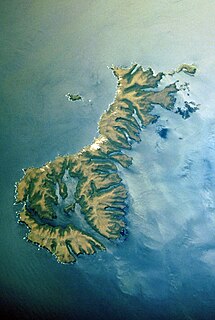
The Auckland Islands are an archipelago of New Zealand, lying 465 kilometres (290 mi) south of the South Island. The main Auckland Island, occupying 510 km2 (200 sq mi), is surrounded by smaller Adams Island, Enderby Island, Disappointment Island, Ewing Island, Rose Island, Dundas Island, and Green Island, with a combined area of 626 km2 (240 sq mi). The islands have no permanent human inhabitants.

The New Zealand sea lion, also known as Hooker's sea lion, and whakahao in Māori, is a species of sea lion that primarily breeds on New Zealand's subantarctic Auckland and Campbell islands and to some extent around the coast of New Zealand's South and Stewart islands. The New Zealand sea lion numbers around 10,000 and is perhaps the world's rarest sea lion species. They are the only species of the genus Phocarctos.

Arctocephalus forsteri is a species of fur seal found mainly around southern Australia and New Zealand. The name New Zealand fur seal is used by English speakers in New Zealand; kekeno is used in the Māori language. As of 2014, the common name long-nosed fur seal has been proposed for the population of seals inhabiting Australia.
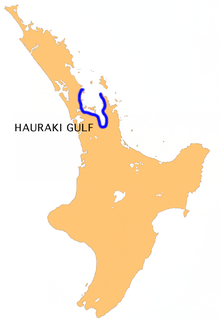
The Hauraki Gulf / Tīkapa Moana is a coastal feature of the North Island of New Zealand. It has an area of 4000 km2, and lies between, in anticlockwise order, the Auckland Region, the Hauraki Plains, the Coromandel Peninsula, and Great Barrier Island. Most of the gulf is part of the Hauraki Gulf Marine Park.

The dumb gulper shark is a rare and endangered deepwater dogfish, known from only along the east coast of Australia and isolated spots north and west of New Zealand. It is also known as the dumb shark, Harrison's deep-sea dogfish, or Harrison's dogfish.
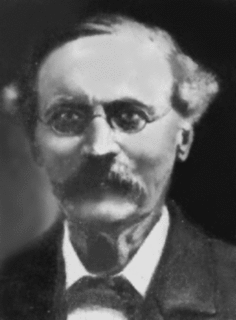
Captain Frederick Wollaston Hutton was an English-New Zealand scientist who applied the theory of natural selection to explain the origins and nature of the natural history of New Zealand. An army officer in early life, he then had an academic career in geology and biology. He became one of the most able and prolific nineteenth century naturalists of New Zealand.
Arthur William Baden Powell was a New Zealand malacologist, naturalist and palaeontologist, a major influence in the study and classification of New Zealand molluscs through much of the 20th century. He was known to his friends and family by his third name, "Baden".
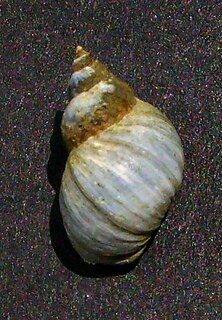
Austrolittorina antipodum, known as the banded periwinkle, is a species of small sea snail, a marine gastropod in the winkles and periwinkles family, Littorinidae. It is found in New Zealand. It occurs in New Zealand.
Lissotestella is a genus of minute sea snails or micromolluscs, marine gastropod molluscs, unassigned in the superfamily Seguenzioidea.
Lissotestella caelata is a species of minute sea snail, a marine gastropod mollusc, unassigned in the superfamily Seguenzioidea.
Lissotestella cookiana is a species of minute sea snail, a marine gastropod mollusc, unassigned in the superfamily Seguenzioidea.
Lissotestella consobrina is a species of minute sea snail, a marine gastropod mollusc, unassigned in the superfamily Seguenzioidea.
Lissotestella tenuilirata is a species of minute sea snail, a marine gastropod mollusc, unassigned in the superfamily Seguenzioidea.
Lissotestella tryphenensis is a species of minute sea snail, a marine gastropod mollusc, unassigned in the superfamily Seguenzioidea.

Nototodarus sloanii is a species of squid commonly known as the New Zealand arrow squid or Wellington flying squid. It is also known by its Māori name of Wheketere. It is a favoured prey species of a number of marine mammals and diving birds. It is an important food source for the New Zealand fur seal and the endangered species: New Zealand sea lion and yellow-eyed penguin. N. sloanii is sought by trawler fishermen for human consumption; in this trawling process, Australian sea lions are frequently killed, since they prey upon N. sloanii.
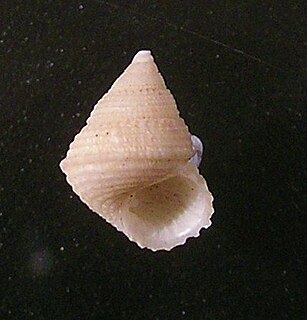
Seguenzioidea is a superfamily of minute to medium-sized sea snails, marine gastropod mollusks in the clade Vetigastropoda.
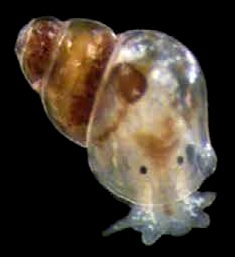
Rissoella is a genus of minute sea snails, marine gastropods, in the family Rissoellidae.
Lissotestella alpha is an extinct species of sea snail, a marine gastropod mollusk, unassigned in the superfamily Seguenzioidea.
Lissotestella basispiralis is an extinct species of sea snail, a marine gastropod mollusk, unassigned in the superfamily Seguenzioidea.
Lissotestella waimamakuensis is an extinct species of sea snail, a marine gastropod mollusk, unassigned in the superfamily Seguenzioidea.
References
- ↑ Rosenberg, G. (2012). Lissotestella rissoaformis. Accessed through: World Register of Marine Species at http://www.marinespecies.org/aphia.php?p=taxdetails&id=598323 on 27 March 2013
- Powell A. W. B., New Zealand Mollusca, William Collins Publishers Ltd, Auckland, New Zealand 1979 ISBN 0-00-216906-1
| This Seguenzioidea-related article is a stub. You can help Wikipedia by expanding it. |